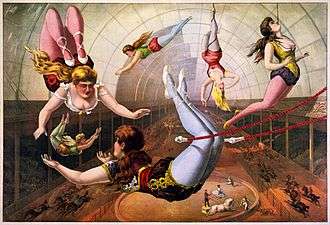Teeterboard
The teeterboard (or Korean plank) is an acrobatic apparatus that resembles a playground seesaw. The strongest teeterboards are made of oak (usually 9 feet in length). The board is divided in the middle by a fulcrum made of welded steel. At each end of the board is a square padded area, where a performer stands on an incline before being catapulted into the air. The well-trained flyer performs various aerial somersaults, landing on padded mats, a human pyramid, a specialized landing chair, stilts, or even a Russian bar.

The teeterboard is manned by a team of flyers, catchers, spotters and pushers. Some members of the team perform more than one acrobatic role. In the early 1960s the finest teeterboard acts, trained in the Eastern Bloc countries, performed with Ringling Brothers and Barnum & Bailey Circus.
Korean-style teeterboard is a form of teeterboard where two performers jump vertically in place, landing back on the apparatus instead of dismounting onto a landing mat or human pyramid. Korean plank acts are featured in the Cirque du Soleil shows Corteo, Mystère, Koozå and Amaluna.
The Hungarian board (bascule hongroise) has a higher fulcrum, and the pushers jump from a height (e.g., from a tower).
